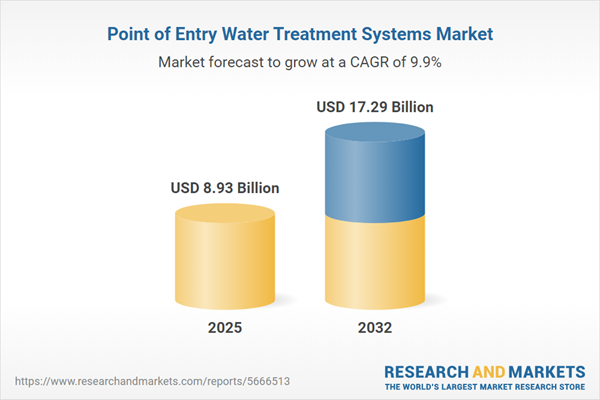Speak directly to the analyst to clarify any post sales queries you may have.
Senior leaders in water-intensive sectors must navigate tightening compliance standards and growing sustainability demands. Understanding the point of entry water treatment systems market enables informed choices around procurement, operational reliability, and long-term business resilience in an evolving risk environment.
Market Snapshot: Point of Entry Water Treatment Systems Market
The global point of entry water treatment systems market is currently valued at USD 8.13 billion, with expectations to reach USD 8.93 billion by 2025 and USD 17.29 billion by 2032, reflecting a compound annual growth rate of 9.87%. Market momentum is shaped by demand for consistent water quality, continued innovation in purification methods, and stronger infrastructure investments. Shifting regulatory protocols and transformations throughout supply chains are influencing sector behavior, as companies in commercial, industrial, and residential domains adapt their strategies to manage compliance and drive efficiencies.
Scope & Segmentation for Executive Decision-Making
This analysis offers actionable segmentation to enhance strategic procurement, risk management, and technology planning for senior decision-makers. Tailoring approaches based on detailed segments empowers organizations to respond dynamically to varying business needs and regulatory conditions worldwide.
- End Use: Commercial clients prioritize regulatory conformity and service dependability; industrial users seek adaptability for diverse water qualities and high throughput; residential consumers require ongoing safety and stable operations.
- Technology: Solutions include activated carbon filtration for organic contaminants, reverse osmosis for dissolved solids, ultrafiltration for particulate control, and ultraviolet light for microbial mitigation, allowing agencies to match technologies to site-specific and compliance objectives.
- Mounting Type: Options such as countertop, faucet-mounted, and under-sink installations offer versatility for upgrades, replacement, and multi-site deployments across various commercial or residential settings.
- Flow Rate: Availability spans high-output systems for industrial operations to steady-flow solutions for business and residential contexts, supporting diverse volume and pressure requirements.
- Material: Key options include plastic and stainless steel, enabling organizations to assess overall lifecycle performance, sustainability alignment, and longevity in line with evolving environmental mandates.
- Geographies: Insight covers North America, Latin America, Europe, Middle East, Africa, and Asia-Pacific, examining unique regulatory processes, supply chain logistics, and market access strategies critical for tailored market entry.
- Key Player Coverage: Executive benchmarking includes leading firms such as Culligan International Company, Pentair plc, A. O. Smith Corporation, Xylem Inc., 3M Company, BWT AG, EcoWater Systems LLC, Kinetico Incorporated, Evoqua Water Technologies LLC, and Watts Water Technologies, Inc., equipping leaders with comparative intelligence for supplier evaluation.
Key Takeaways for Strategic Leadership
- Deploying real-time monitoring and analytics solutions strengthens organizational oversight across multiple locations and supports efficient risk mitigation for essential operations.
- Modular treatment technologies provide organizational flexibility, ensuring readiness for updated regulations, sustainability benchmarks, and market shifts, supporting dynamic business needs.
- Choosing environmentally responsible and recyclable materials contributes directly to ESG ambitions, allowing firms to maintain alignment with established international sustainability practices.
- Customizing procurement and maintenance actions according to local regulatory standards facilitates improved cost management and operational continuity, especially for businesses with a diverse geographic presence.
- Developing adaptable supply networks supports mitigated disruption from compliance changes and strengthens consistency in system availability, reinforcing operational reliability.
2025 Tariff Impact & Supply Chain Response
Revisions to U.S. tariffs are prompting companies to reassess sourcing and distribution for water treatment assets. Strategic responses—such as diversifying vendors, building regional partnerships, and refining procurement protocols—allow businesses to absorb cost fluctuations and maintain regulatory alignment, even as tariff landscapes or supply chain structures evolve.
Methodology & Data Sources
Content in this report draws from interviews with market operators, insights from regulatory bodies, and expertise from supply chain authorities. Analytical findings are reinforced by a rigorous, up-to-date review of relevant technical literature, ensuring actionable recommendations for decision-makers in the water treatment field.
Why This Report Matters for Water Treatment Stakeholders
- Segmented research supports proactive management of compliance, operational, and financial decisions within the point of entry water treatment systems market.
- Validated insights strengthen technology evaluation and regulatory adherence for complex procurement and multi-region operations.
- Actionable recommendations empower leaders to adjust sourcing and sustainability strategies effectively, ensuring resilience and ongoing performance as regulations evolve.
Conclusion
This report equips decision-makers with actionable intelligence, supporting excellence in procurement, sustainable operations, and resilience as the point of entry water treatment systems market transforms globally.
Additional Product Information:
- Purchase of this report includes 1 year online access with quarterly updates.
- This report can be updated on request. Please contact our Customer Experience team using the Ask a Question widget on our website.
Table of Contents
3. Executive Summary
4. Market Overview
7. Cumulative Impact of Artificial Intelligence 2025
Companies Mentioned
The companies profiled in this Point of Entry Water Treatment Systems market report include:- Culligan International Company
- Pentair PLC
- A. O. Smith Corporation
- Xylem Inc.
- 3M Company
- BWT AG
- EcoWater Systems LLC
- Kinetico Incorporated
- Evoqua Water Technologies LLC
- Watts Water Technologies, Inc.
Table Information
| Report Attribute | Details |
|---|---|
| No. of Pages | 186 |
| Published | November 2025 |
| Forecast Period | 2025 - 2032 |
| Estimated Market Value ( USD | $ 8.93 Billion |
| Forecasted Market Value ( USD | $ 17.29 Billion |
| Compound Annual Growth Rate | 9.8% |
| Regions Covered | Global |
| No. of Companies Mentioned | 11 |









